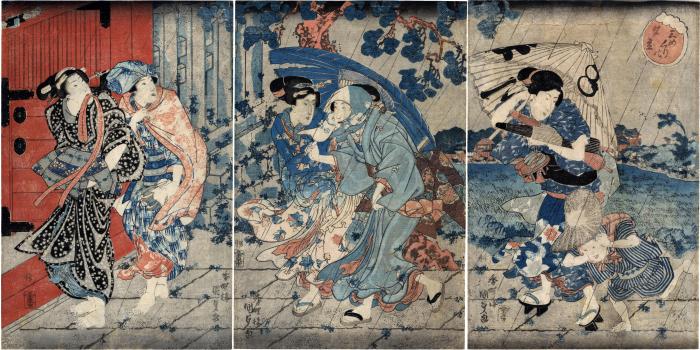Utagawa Kunisada (歌川国貞) / Toyokuni III (三代豊国) (artist 1786 – 01/12/1865)
Sudden Shower at the Mimeguri Shrine (三囲の夕立)
1844 – 1845
29.25 in x 14.75 in (Overall dimensions) Japanese woodblock print
Signed: Kōchōrō Kunisada ga
香蝶楼国貞画
Publisher: Izumiya Ichibei
(Marks 180 - seal 21-235)
Nanushi censor seal: Tanaka [Heijirō 田中平四郎]
Hagi Uragami Museum of Art - right panel
Hagi Uragami Museum of Art - center panel
Hagi Uragami Museum of Art - left panel
From Mimeguri (三囲) to the Washington Monument at Vegder's Blog
Ritsumeikan University - black and white reproduction of right-hand panel
Ritsumeikan University - black and white reproduction of middle panel
Ritsumeikan University - black and white reproduction of left-hand panel
National Museums of Scotland - left-hand panel only
Lyon Collection - a very fresh copy of the right-hand panel
Victoria and Albert Museum - left panel only
Victoria and Albert Museum - right panel only
Victoria and Albert Museum - center panel only The theme of 'A Sudden Shower at the Mimeguri Shrine' had already been dealt with by Kiyonaga in a triptych in 1787. In that version there are thunder, i.e., storm demons in the sky.
In the Bulletin of the Museum of Fine Arts in 1916 it states: "Men and women are seeking shelter in a gateway. Above, in the clouds, the demons of a thunder-storm are conferring over a haiku (a short poem in seventeen syllables) composed by the Japanese poet, Kikkaku (1661-1707).
The reference is to a tradition that on the 28th of June, in the year 1693 Kikkaku went with his disciples to the Mimeguri Inari Shrine, at Mukojima, Tokyo, where, to his surprise, he encountered a crowd of highly excited farmers. Upon inquiry he learned that they had been praying for rain to terminate the long drought which threatened their crops with ruin, and in response to suggestions from his companions, coupled with the persistent appeals of the farmers, - who, because of his bald head, mistook him for a Buddhist priest, - he composed the following haiku, which he recited with great earnestness before the altar:
'If thou art indeed the God who watched over farms, send forth, I pray, thy showers!'To the great delight of all this prayer was instantly answered, and the nourishing rain descended in torrents. The Japanese expression meaning 'watch over,' as used in the foregoing poem, is mimeguri, a homonym of the name of the Shrine. Such plays upon words are a marked characteristic of Japanese poetry."
****
There is another copy - #623 - of the right-hand panel in the Lyon Collection. That one is near perfect in its condition and coloring.
****
The Mimeguri Shrine is located on the right bank of the Sumida River, across from the Asakusa district. This shrine was dedicated to 2 of the 7 propitious gods: Ebisu and Daikoku. Therefore they were destinations for people who were praying for prosperity.
Many other artists, besides Kunisada, did prints which dealt with the area close to and centered on the Mimeguri area. Many Edo travelers stopped there to dine at favorite restaurants or rest at local teahouses while on their way to the Yoshiwara.
****
Other artists who produced prints referencing Mimeguri or its district include Harunobu, Buncho, Kiyonaga, Masayoshi, Toyoharu, Toyohiro, Utamaro, Choki, Eishi, Shunman, Toyokuni I, Shuntei, Kuniyasu, Hokusai, Kuniyoshi, Eisen, Shunko, Hiroshige, Sadakage, Hiroshige II, Hiroshige III, Ikkei, Yoshiiku, Yoshitoshi and Kiyochika.
Izumiya Ichibei (和泉屋市兵衛) (publisher)
beautiful woman picture (bijin-ga - 美人画) (genre)
boshi-e (母子絵) (genre)
mitate-e (見立て絵) (genre)
